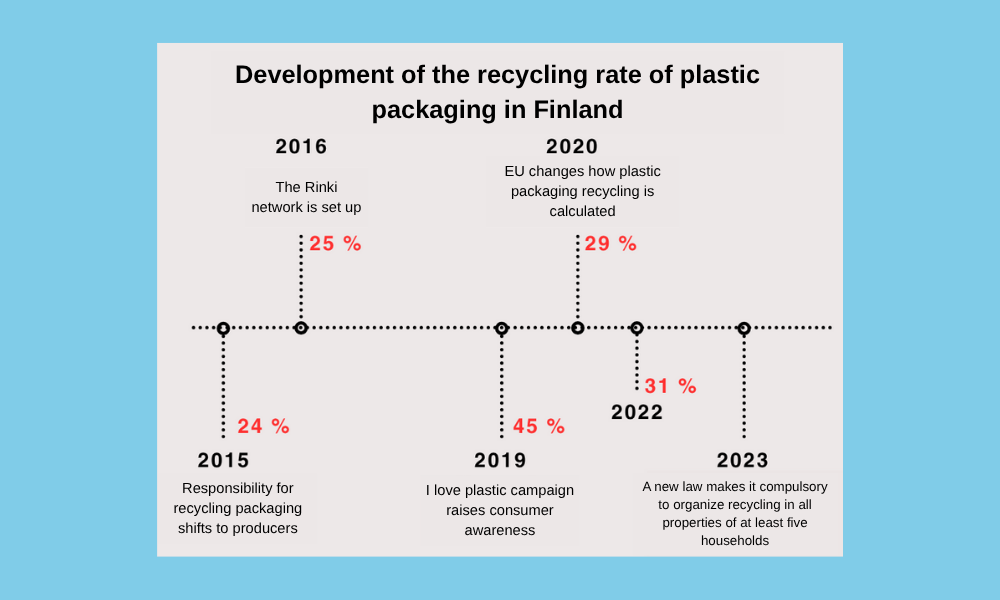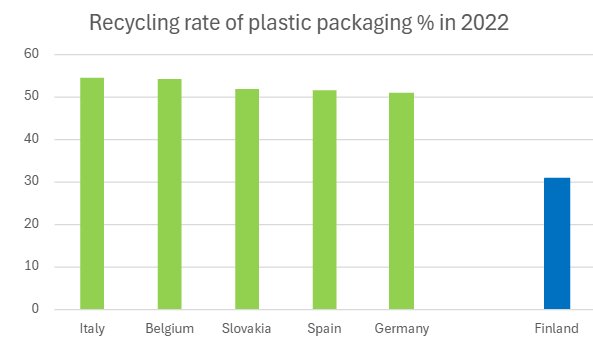Recycling of plastic packaging has advanced significantly in Finland – EU target will still not be achieved this year.

The recycling of plastic packaging expanded from separately collected business packaging and plastic deposit bottles to all plastic packaging in 2015, when responsibility for packaging recycling shifted to packaging producers. The new law led to the creation of the Rinki-ecopoint network in 2016. The overall recycling rate of plastics, supported by Finnish Broadcasting Company YLE’s notable I Love Plastic campaign, already reached 45 % in 2019. The campaign had a positive impact on consumer attitudes by raising awareness of the recycling of plastics and is successfully highlighted the products that can be made from recycled material.
Just when we were on track to reach a 50 % recycling rate, the calculation of plastic packaging recycling in the EU was changed in 2020. Previously the sorted and collected plastic for recycling had been reported as a whole, now the non-recyclable plastic was deducted from the amount collected separately. At the same time, an estimate of the quantities placed on the market by companies not affiliated to producer organisations was added to the volume of plastic packaging. With the new reporting model, the official recycling rate of Finland collapsed to 29 %. Recycling rates in other countries also decreased more or less.
-The correction of the reporting model was a good reform in the sense that it took reporting in the right direction. After the reform, only such plastic waste is reported, which really can be reused as material, says Marko Turunen, Operations Director of Rinki.
There was a further change in legislation in 2023, the aim of which was to increase the rate of plastic recycling. The new law required packaging producers to organise, in cooperation with municipalities, the collection of plastic packaging from all properties of five or more households. The benefits of this change are not yet visible in official data because the most recent available statistics are from 2022. Rinki has however observed that the volume of recycling has taken a turn into the right direction.
-The volume of sorted plastic waste has increased in the beginning of the year in the Rinki collection points. The awareness of people has clearly increased and with communication we have been able to do away with misconceptions related to recycling, such as, that plastic packaging should be washed before sorting, reports Turunen.
Still, there is room for improvement because on average Finnish households only sort 3-4 plastic packaging out of ten.
Almost all Member States still have a way to go to reach the EU target
EU has set a target of 50 % recycling of plastic packaging in all Member States by 2025. There is still a long way to go in Finland, with a recycling rate for plastic packaging of 31 % in 2022.
-This year we will not reach the targets, but we are already close. The target will be achievable in the coming years, as technology for recycling has evolved and the awareness of people has increased, Turunen says.
This is a challenge for almost all countries.
-The situation varies enormously across the 27 Member States. Only around 3-4 countries are at a very good level, while more than half of the Member States will not reach the target this year, says EXPRA Managing Director Joachim Quoden. EXPRA is an association representing packaging producer organisations.
Quoden estimates that no more than 25 % of the 27 Member States will meet the target.
-I am very optimistic about Belgium and Italy, and the situation in Germany, the Netherlands and the Czech Republic is also quite good. For other countries, the situation is challenging, Quoden says.
Member States have very different starting positions, cultures and waste management systems. The best performing countries have a highly integrated waste management system that includes the possibility of recycling of all kinds of waste.
-Regrettably, it is very difficult for Member States to take advantage of the best practices of other countries, as they mainly favour their own national approach, Quoden clarifies. In order to achieve this goal, good cooperation throughout the supply chain is essential. There is scope for improvement in many countries since, according to Quoden, in some countries, not all parties are aware of the activities of others.
Statistics, the reliability of which is a source of debate, present their own challenge in assessing packaging recycling in the EU. Reliable statistics are a prerequisite for a reliable comparison of collection and recycling systems and the recycling rates achieved by different countries. It is therefore important that the Commission strives to harmonise the criteria for collecting data in the Member States.
The table shows the five best performers in plastic packaging recycling and Finland according to Eurostat statistics.
